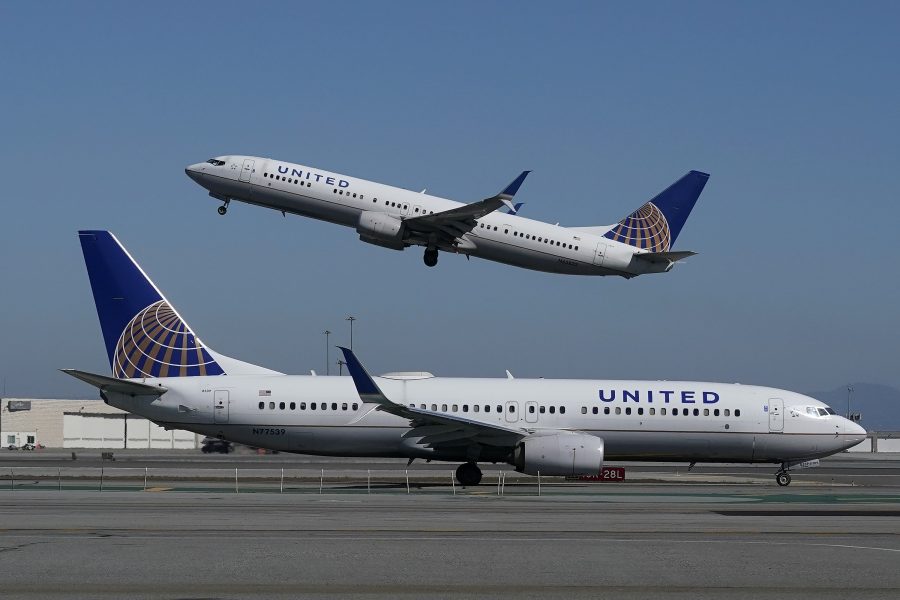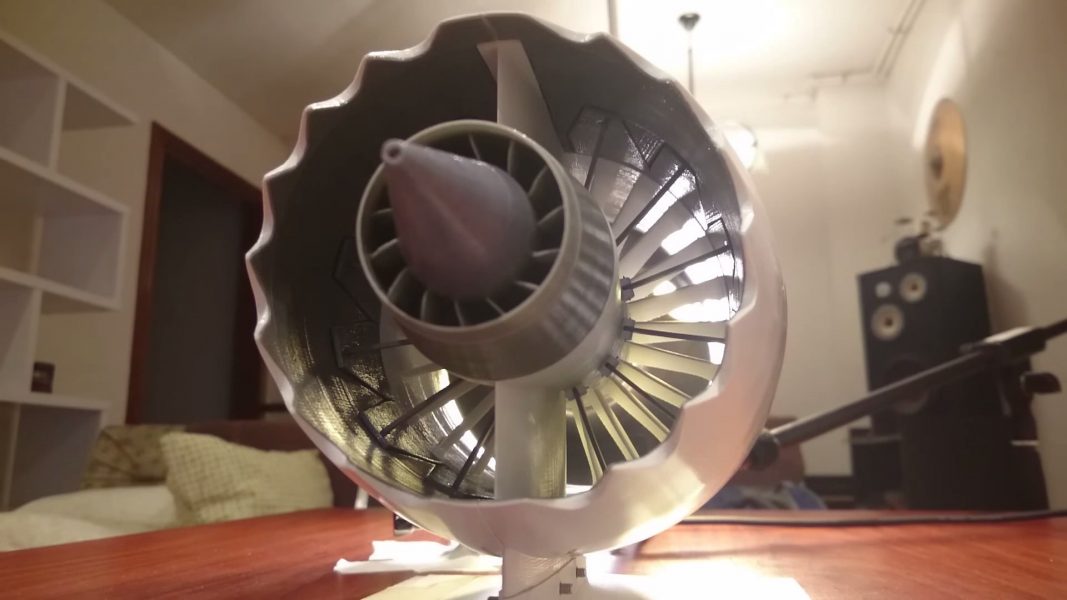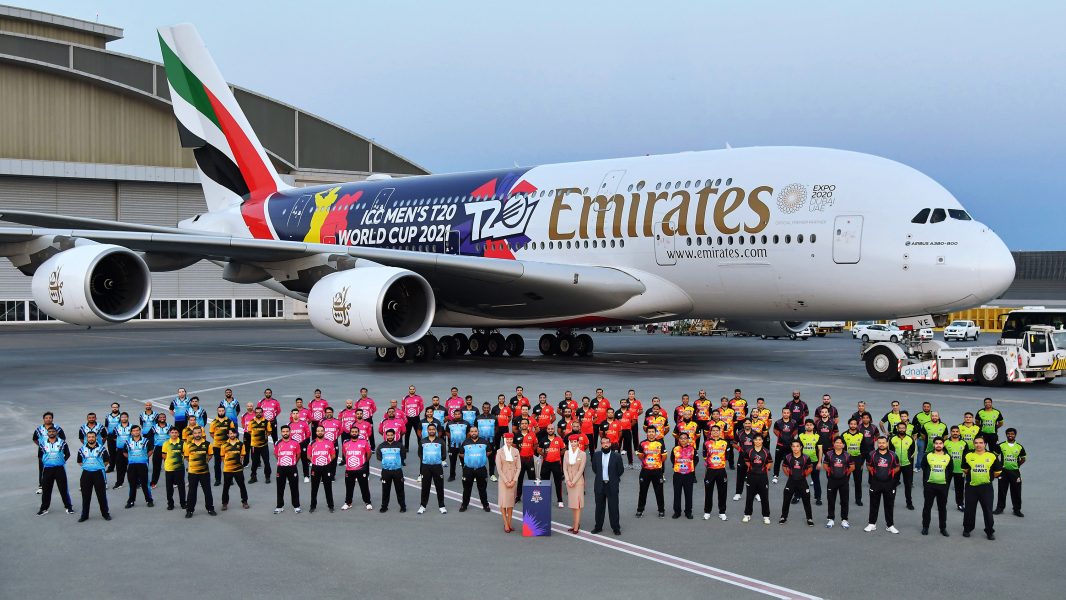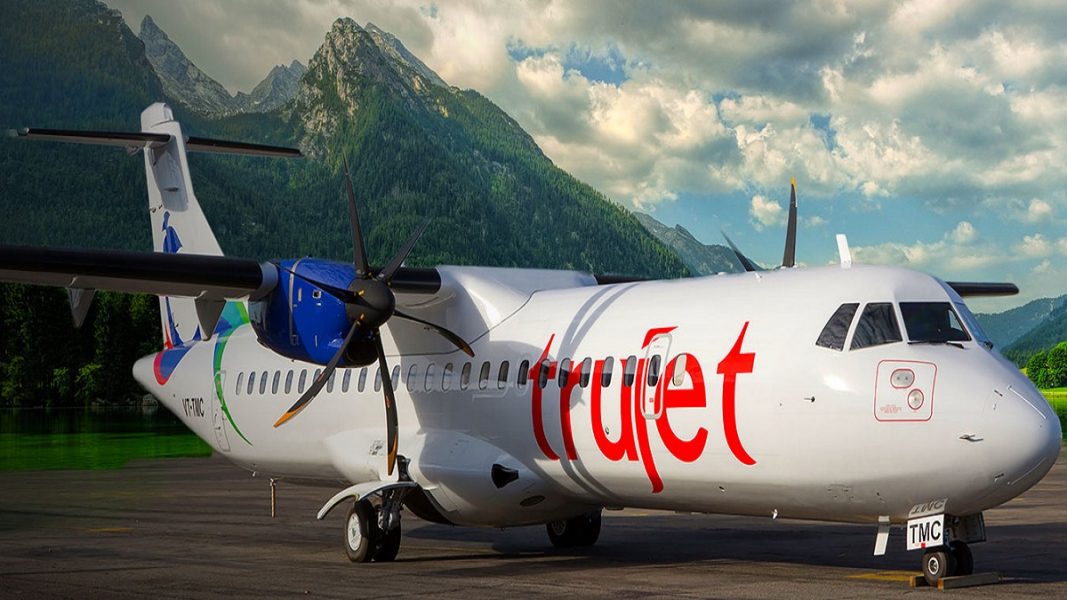Grand Ambitions
Emirates is one of the only airlines to have a dedicated in-house Aircraft paint shop and to top it up, it's the largest facility in the world. Located at Dubai International Airport, Emirates paint hangar is more than twice the size of a football field and operates 24x7.
Emirates A380 with T20 colours
Efficiency and Marketing
Aircraft livery is one of the most recognizable and visible aspects of an airline brand image. It is what people see in the sky, and the first thing passengers notice at their boarding gates. The paint coat also has a performance aspect to it, it has to withstand fierce weather conditions, including severe wind, bitter cold and searing heat, and an exterior coat that is clean of debris and imperfections improves aerodynamics and reduces fuel consumption. Building its own paint hangar has helped the airline to have better quality control and minimum disruptions at the same time utilizing it as a brand marketing campaign. Today, Aircraft are completely stripped after 7-8 years in service and given a brand new coat. A Boeing B777 requires a team of 26 to 30 people for a full strip-and-repaint project, which is turned around in just 12 to 13 days.
Indian Players
India based MRO organization, Air Works group was the first to introduce aircraft livery and painting offering in the country. The Company acquired Air Livery, UK and Aero Technique Espace (ATE), France to become Europe's largest independent aircraft painting or refinishing company in 2010.
Today, Air Works operates a dedicated 2500 sqm Narrow body hangar at its maintenance facility in Hosur, Tamil Nadu. The state-of-the-art hangar can accommodate 1 Narrowbody or Turboprop aircraft such as Airbus A320 family, Boeing B737NG family, ATR-42/72, or 2 Business jets at a time, or as many as 4 rotary-wing aircraft simultaneously.
Images - Emirates, Dubai Press
Read next
With over 100 years of commercial flying, here's how air travel looked like in every decade
Prashant-prabhakar
17 Oct 2021
Flights in the past were not so glamorous and sophisticated as the ones we see today. From cold, unpressurized aircraft to the state-of-the-art in-flight systems we have now, aeroplanes have come a long way.
Here's a lowdown of what air travel looked like in every decade:
1. The 1920s saw planes exclusively designed for passengers
Passengers were often stacked close to each other | loveEXPLORING
In contrast to the planes we have today, flights back then were highly compact, seating 20 passengers almost and most had to be bundled together. With a maximum service ceiling of 3000ft and clocking speeds of around 300kmph, they often had to stop for refuelling. Red-eye flights weren't even a thing and quite interestingly, train journeys were faster than air travel.Planes made of uninsulated sheet metal shook the aircraft loudly in the winds, making it all the more uncomfortable for flyers.Furthermore, the cabins were unpressurized and it really got loud and cold.
2. Introduction of the flight attendants in the 1930s
The first stewardess- ELLEN CHURCH | Owlcation
The 1930s saw the arrival of the first female flight attendants, "stewardess"-as they were known back then, on the scene. Airplane cabins were now soundproofed, heated and seats were upholstered. With improved services, air travel became more comfortable and the first pressurised commercial transport plane was launched in 1938.The planes could also fly much higher, reaching an altitude of around 20,000 feet, which reduced turbulence and made travel by aircraft a lot faster (around 200 mph).The first African-American flight attendant, Ruth Carol Taylor, didn't take to the skies until 1958.
3. The onset of World War II changed the face of air travel
Representative | History.com
Planes were now designed for the sole purpose of war, rather than commercial.
Few members of minority groups flew before World War II. But as the economy rapidly expanded and the number of minority-owned businesses increased, more people of color began to flyAccording to the Smithsonian National Air and Space Museum.
Discrimination was rampant as air travel was mostly white.
After the end of the war, Europe and the US were now left with innumerable planes and airbases, which was repurposed for commercial flights.
4.1950s- The golden age of air travel
The golden age of commercial flying(the 50s-60) | Reddit
Although known to be as the bees and knees of air travel, flying in the 1950s was anything but cheap.Booze was served in fancy glassware, and meals consisted of dishes like roast beef, lobster, and prime rib. Flying was glamorous and people got what exactly they paid for.
5. Flying- A mundane, relaxed affair up until the 1960
A striking feature of flying in the 1960s was that passengers could now fly without an ID with loved ones walking all the way up to the gate to send people on their way.Furthermore, passengers could show up at the airport half an hour before departure and walk straight up to the gate.
5.1970- Bigger flights meant more passengers and that meant increased security
Security screenings weren't mandatory until 1973, and even then, those were pretty relaxed as opposed to the ones in place today." From 1970 to around 1974, American Airlines even featured a piano lounge in the rear of their 747s, while Pan Am's 707 Clipper was advertised as being "vibration-free."
5. "No smoking" in aircraft cabins today. Not exactly so back in the 80s!
In the 1980s you could smoke cigarettes, meals were included, and there was no cap on the number of bags you could check-in. Sounds fun? There's more.
Airlines experimented with the idea of having a "lounge/pub in the skies".Continental Airlines (now United Airlines) even tested out a "Pub" configuration complete with a bar stocked with alcohol and circular tables surrounded by swivel chairs.Additionally, passengers could also visit the cockpit and children were given a sneak-peek to remember the experience.
Glamorous airline lounges from the 1970s | VinePair
5.The 1990s coming of age
Some notable features of flying in the 90s were all passengers of age, including economy, could indulge in free liquor on international and domestic flights.Free inflight meals were served and inflight entertainment was in its infancy.
6. Significant changes post 9/11
Travel+Leisure
Post 9/11, airport security became much stringent, cockpit doors were reinforced and locked and only ticketed travellers were allowed at airline gate areas. Before this, travellers could go through security with items including liquids, small pocket knives, and wearing bulky jackets. Before 9/11, the Transportation Security Administration (TSA) didn't even exist.
7. 2010- Increased passenger expectations
Smarter Travel
From private touchscreens to USB chargers in every seat, passengers expected all amenities on board. Consequently, free meals saw a decline as airlines had to charge extra for carry-ons and seat assignments.
8. 2020- The onset of the global pandemic
Getty Images
The pandemic changed the entire course of the aviation industry and much has changed since then.From blocking middle seats to ensure social distancing to halting food services, airlines have had to adopt not-so-fancy measures to ensure passengers felt safe and to help curb the spread of COVID-19.
Did you know? The story of commercial air travel begins before the 1920s, in 1914 when the world's first scheduled passenger service set off between Tampa and St Petersburg, piloted by Tony Jannus
COVER: Reddit
Read next
United Airlines will begin operating daily flights from Bengaluru to San Francisco
Radhika Bansal
16 Oct 2021

Passengers flying from India to San Francisco will be pleased to hear some good news. United Airlines, based in the United States, said on Thursday, October 14 that it will begin a daily flight between Bengaluru and San Francisco on May 28, 2022.
The airline went on to say that the new route complements its existing flights from New Delhi to Newark, Chicago, and San Francisco, as well as Mumbai to Newark.
The new route (service) is United's first-ever nonstop service between Bengaluru and the United States, according to the airline.
(Image Courtesy - United Cargo)
American will start nonstops between Delhi and New York from October 31, 2021. Delta is yet to resume India flights. While AI has the maximum nonstops between North America and India, United is the biggest US carrier in terms of services to India.
Notably, the services of United Airline from Bengaluru to San Francisco will be operated with Boeing 787-9 Dreamliner aircraft, featuring a total of 257 seats — 48 flat-bed seats in business class, 21 seats in premium-plus class and 188 seats in economy class.
“We are excited to announce the start date for our highly anticipated first-ever service between the two international technology hubs, Bengaluru and San Francisco. Our new flight strengthens our international route network, provides our customers from India with even greater travel choice and the possibility to connect via our San Francisco hub to other destinations across the Americas.”Marcel Fuchs, Managing Director, International Sales, United Airlines
United Airlines said it offers more flights between India and the US than any other US carrier.
The fresh flight announcements from United Airlines comes at a time when the scheduled international passenger services have been suspended in India since March 2020 due to the coronavirus pandemic. However, special international flights have been operating under the Vande Bharat Mission since May 2020 and bilateral “air bubble” arrangements with selected countries, including the US, since July 2020.
Nonstop Flights between USA and India:
Chicago (ORD) to Delhi (DEL) by Air IndiaNew York (JFK) to Delhi (DEL) by Air IndiaSan Francisco (SFO) to Delhi (DEL) by Air IndiaWashington (IAD) to Delhi (DEL) by Air IndiaNewark (EWR) to Mumbai (BOM) by Air IndiaChicago (ORD) to Hyderabad by Air India (new)SFO to Bengaluru (BLR) by Air India (new)Newark (EWR) to Delhi (DEL) by United AirlinesNewark (EWR) to Mumbai (BOM) by United AirlinesSan Francisco (SFO) to Delhi (DEL) by United AirlinesNew York (JFK) to Mumbai (BOM) by Delta AirlinesChicago to Delhi by United Airlines (December 2020)San Francisco to Bengaluru by United Airlines (2021)
(Image Courtesy - WISN)
United Airlines is one of the world’s largest airlines, following the merger with Continental Airlines in 2010. The carrier operates an extensive domestic and regional network of services from its main domestic hubs at Chicago O’Hare, Denver, Houston George Bush, Los Angeles, Newark Liberty, San Francisco, Washington Dulles and Guam airports.
United Airlines utilises a large fleet of narrow and wide-body Airbus and Boeing aircraft and operates international services to Central America, South America, Asia, Australia, Europe and Africa. It is also a founding member of the Star Alliance.
Read next
SpiceJet's licence to transport dangerous commodities provisionally suspended by the DGCA
Radhika Bansal
16 Oct 2021
The DGCA has temporarily banned SpiceJet's licence for the carriage of 'hazardous commodities' due to alleged infractions. SpiceJet will not be allowed to transport dangerous products, including lithium-ion batteries, on either domestic or international flights during the 30-day suspension, according to the sources.
When contacted, a SpiceJet spokesperson did not directly mention the suspension.
The airline said there was a "minor issue" with a package being declared as a "non-dangerous goods" by a shipper, who has been blacklisted.
According to the Directorate General of Civil Aviation's (DGCA) rules, dangerous goods are articles or substances that are capable of posing a risk to health, safety, property or the environment.
"The DGCA has suspended SpiceJet's licence for dangerous goods for 30 days allegedly for violating norms involved in the handling of such cargo," one of the sources said.
As a consequence, the airline has been "barred" from carrying such cargo on its flights across the network, he said.
Director-General of Civil Aviation Arun Kumar was not reachable for comments.
"There was a minor issue with a package being declared as 'non-dangerous goods' by a shipper and the lapses were on the shipper's part. SpiceJet has taken preventive and corrective action as advised by the DGCA," the SpiceJet spokesperson said in a statement.
Read next
Pratt and Whitney's prototyping arm, Gatorworks, to 3D print an entire jet engine
Prashant-prabhakar
16 Oct 2021

The last time Pratt & Whitney’s GatorWorks attempted to 3D-print a combustor for the miniature TJ-150 jet engine, the results were less than impressive-to say the least.
Actually, it was terriblesays Dave Stagney, senior director of P&W’s prototyping arm.
The maiden attempt had been a learning experience for the team who is now taking the whole additive process a notch higher- attempting to produce a TJ-150 turbine entirely out of 3D-printed parts.
We learned a lot from it. We need to create the opportunities for our engineers to learn, and not put ourselves in a situation where the stakes are so high that we have to be so conservative that we can’t take calculated risksStagney
FlightGlobal
For now, Gatorwork's main focus is on low-cost military engines such as the TJ-150, which is used to power small cruise missiles and not the conventional, ultra-reliable turbofan engines used on fighter jets or commercial planes.The company aims to cash in on the US Air Force’s (USAF’s) growing demand for low-cost cruise missiles, powered glide bombs and “attritable” unmanned air vehicles (UAVs). After years of acquiring high-end fighter jets with ginormous prices, like the Lockheed Martin F-35 stealth fighter, the USAF now wants to incline more towards inexpensive platforms.
Gatorworks, having being launched in mid 2018, relies heavily on digital technology such as model-based systems engineering software, and the agile development method-an iterative approach borrowed from the Silicon Valley software programming.
3D printing vs Subtractive manufacturing
Significant 3D printing forecast surges to $35.6 billion | Forbes
3D printing allows for faster manufacturing of components using digital designs. This makes it possible to furnish components with geometries , impossible to create with traditional mills and lathes.
P&W thinks it can consolidate the TJ-150’s number of parts from 400 to about 6
TJ-150 | PBS Aerospace
TJ-150 is a 150lb-thrust (0.667kN) turbine engine that powers the Raytheon Miniature Air-Launched Decoy, a low-cost cruise missile intended to confuse enemy air defence systems.It also powers the MBDA Spear air-to-surface missile, which is to be fielded on the UK Royal Navy’s carrier-based Lockheed Martin F-35B fleet.
3D printing an engine has its own set of advantages. Besides cutting the process costs in half, it also saves a considerable amount of time as opposed to when subcontracting the work to outside entities.
Right now, if we want to do an iteration, we’ve got hard tooling that’s about a 12-month lead time. If we can do additive, we can eliminate that lead time and print new configurations in a couple of weeksStagney
Furthermore, rotating parts are the most difficult because of the high stresses and dynamics those parts experience-he added.
If all goes well, the 3D-printed TJ-150 should be ready to roll by the end of the year.
David Stagney | GovCon wire
If it doesn’t work, well, we’ll do another (s)printStagney
COVER: Softpedia
Read next
For an undisclosed sum, Megha Engineering & Infrastructures Ltd (MEIL) has returned ownership of cash-strapped TruJet to its former owner Vankayalapati Umesh. On October 9, Umesh took over as Managing Director, even though the majority of TruJet's board of directors had left.
In an e-mail to the airline's staff, Umesh stated that Ireland-based turboprop aircraft lessor Elix Aviation Capital is interested in becoming an equity partner as well as leasing 10 aircraft, two of which are available immediately.
(Image Courtesy - Airways Magazine)
Turbo Megha Airways Private Limited was incorporated on March 14, 2013, with Vankayalapati Umesh as the promoter. In 2014, he sold a majority stake in the airline to Hyderabad-based Megha Engineering and Infrastructures Limited to fund their operations.
The carrier’s new MD confirmed to Business Line that he is in the process of restructuring the airline.
According to a report by Hindu Business Line, Vankayalapati Umesh said -
“I am at advanced stages of discussion with entities for institutional funding and to raise funds for the airline and I believe to be able to conclude the same in the next three months.While it impacted in a huge cash outflow for the parent company, MEIL realised that this was not part of its core business functions and wanted to handover the airline business to someone capable and keen on its safekeeping and continuous expansion.I am at advanced stages of discussion with entities for institutional funding and to raise funds for the airline and I believe to be able to conclude the same in the next three months.Our existing lessor, Elix Capital, is also keen on leasing 10 aircraft to us with two aircraft immediately. They also want to be equity partners in the airline and will bring in value by way of aircraft induction and their global relationship in the aviation industry.MEIL has put its faith and trust in me to run this airline and has transferred the company to me."Vankayalapati Umesh
A spokesman for MEIL declined to respond. A source close to MEIL's promoters, on the other hand, verified that the airline had been sold to Umesh.
Turbo has been looking for an investor for six months and has been unable to find one. Interups' Laxmi Prasad stated that he would invest in the company. However, he has yet to pay any money to the company. TruJet and US-based firm Interups Inc signed an agreement in April under which Interups committed to buying a 49% ownership in the company for an undisclosed sum. Although the agreement was viewed as a tremendous relief for the cash-strapped airline, Interups has yet to infuse the funds as agreed.
When BusinessLine contacted Prasad to ask if he was asked to leave, he maintained that he was still a part of the company. However, when asked if he had infused the agreed funds, he did not comment.
(Image Courtesy - MouthShut.com)
Elix Aviation Capital is backed by California-based asset management firm Oaktree Capital Group, and currently owns and manages a portfolio of 65 turboprop aircraft.
Trujet, according to the MD, has been operating for 4.5 years, expanding gradually until the pandemic hit and like all businesses globally and locally, the carrier was affected by the lockdown and the severity of Covid-19.
According to a source, TruJet will need INR 300 crore immediately to stay afloat.
Founded in 2013 and beginning operations in July 2015, TruJet (Turbo Megha Airways) is an Indian low-cost carrier based at Hyderabad Rajiv Gandhi International Airport. The carrier operates a route network primarily focusing on the country's central Andhra and Telangana regions, with destinations including Tirupati, Hyderabad, Aurangabad, Vijayawada and Rajahmundry. TruJet utilises a fleet of ATR-72 aircraft. The carrier is backed by Turbo Aviation, diversified Indian aircraft maintenance and ground handling company.
(Image Courtesy - Indica News)
However, like many airlines, TruJet also buckled under COVID-related losses to the point where it had to ground most of its fleet earlier this year and risk losing its flying license. As of now, out of the carrier’s seven ATR 72, only one is in active service.
Most of the funding was slotted for the airline’s expansion, with Interups Chairman Laxmi Prasad announcing a potential order of more than 100 Embraer E190s and Airbus A220s.
(With inputs from the Hindu Business Line)
Cover Image - India TV News




Comment